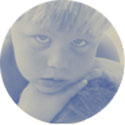Chronicity. PTSD is a long-lasting, chronic disorder for young patients. Symptoms have been found to persist in one-third of children 2 years after the initial diagnosis.10
Comorbidity in childhood PTSD is the norm. Among the conditions frequently encountered with childhood PTSD are major depression, dysthymia, substance abuse, anxiety disorder, attention-deficit/hyperactivity disorder (ADHD), conduct disorder, and oppositional defiant disorder.
Steven’s story, continued. At psychiatric referral, Steven had a history of aggression towards other children. He had no friends and usually played alone. He had difficulty sleeping and awoke frequently during the night. Several times daily he displayed temper tantrums with kicking and screaming.
The boy was unable to discuss the abuse that had happened to him but displayed severe aggression when playing with dolls in the office. He stripped off their clothes, examined their private parts, then ripped them apart or threw them across the room. His language development showed significant delays, both in expression and comprehension.
Organic basis for PTSD in children?
Studies of the hypothalamic-pituitary-adrenal (HPA) axis and of brain volume have revealed physiologic changes that may indicate PTSD in children. These changes could be the result of PTSD or a risk factor for its development.
HPA axis dysregulation. One of the first controlled studies of biological and physiologic changes in children with PTSD found elevated levels of dopamine, norepinephrine, and free cortisol in 24-hour urine specimens of maltreated children. Urinary catecholamine and free cortisol concentrations were positively correlated with the duration of PTSD trauma and symptom severity.11,12
Elevated afternoon salivary cortisol levels have been found in depressed, maltreated children compared with depressed children who had not been maltreated.13 Girls ages 5 to 7 who had been abused in the past 2 months were found to have lower salivary cortisol levels than normal controls.14 A controlled study found significantly elevated salivary cortisol levels in 51 children with PTSD, compared with 31 controls. Interestingly, cortisol levels in the PTSD group were significantly higher in girls than in boys.15
The effect of trauma on the HPA axis in children requires more research. Although these studies produced contradicting results, elevated cortisol levels seem to be found more consistently than depressed cortisol levels. The differences in outcome could be related to the groups studied or to variations in adrenal system response among subjects.
Brain volume. Changes in brain volume have been measured in maltreated children using MRI readings analyzed with IMAGE software developed by the National Institutes of Health. Intracranial and cerebral volumes of 44 children with PTSD were found to be smaller than those of 61 matched controls.12 Specifically:
- Children who experienced abuse at the earliest ages and for the longest periods had the smallest brain volumes.
- Maltreated children with the smallest brain and corpus callosum volumes displayed the most severe PTSD symptoms (intrusive thoughts, avoidance, hyperarousal, and dissociation).
- Corpus callosum areas and cerebral volumes were reduced more in maltreated boys than in maltreated girls.
- Hippocampal volumes were not decreased in maltreated children, unlike findings reported in adults with a history of PTSD.
The traumatic event is persistently re-experienced in one (or more) of the following ways:
- recurrent and intrusive distressing recollections of the event, including images, thoughts, or perceptions. Note: In young children, themes or aspects of the trauma may be expressed in repetitive play.
- recurrent distressing dreams of the event. Note: Children may experience frightening dreams without recognizable content.
- acting or feeling as if the traumatic event were recurring (includes a sense of reliving the experience, illusions, hallucinations, and dissociative flashback episodes, including those that occur upon awakening or when intoxicated). Note: In young children, trauma-specific re-enactment may occur.
- intense psychological distress at exposure to internal or external cues that symbolize or resemble an aspect of the traumatic event.
- physiological reactivity on exposure to internal or external cues that symbolize or resemble an aspect of the traumatic event.
PROPOSED CHANGE FOR YOUNG CHILDREN
Only one re-experiencing symptom is required from the following
- posttraumatic play
- play re-enactment
- recurrent recollection
- nightmares
- episodes of objective features of a flashback or dissociation
Source: Adapted from DSM-IV-TR and Scheeringa et al. J Am Acad Child Adolesc Psychiatry 1995;34:191-200.
In a recent study, the same researchers16 reported that superior temporal gyrus gray matter volumes measured with MRI were larger in 43 maltreated children and adolescents compared with controls, but white matter volumes were smaller in the maltreated group. The authors suggested these findings may represent developmental alterations in maltreated children. Other MRI studies have found:
Persistent avoidance of stimuli associated with the trauma and numbing of general responsiveness (not present before the trauma), as indicated by three (or more) of the following:
- efforts to avoid thoughts, feelings, or conversations associated with the trauma
- efforts to avoid activities, places, or people that arouse recollections of the trauma
- inability to recall an important aspect of the trauma
- markedly diminished interest toward participation in significant activity
- feeling of detachment or estrangement from others
- restricted range of affect (e.g., unable to have loving feelings)
- sense of a foreshortened future (e.g., does not expect to have a career, marriage, children, or a normal life span)

PROPOSED CHANGE FOR YOUNG CHILDREN
Only one symptom is needed from the following:
- constriction of play
- socially more withdrawn
- restricted range of affect
- loss of acquired developmental skills (especially language and toilet training)
Source: Adapted from DSM-IV-TR and Scheeringa et al. J Am Acad Child Adolesc Psychiatry 1995;34:191-200.

